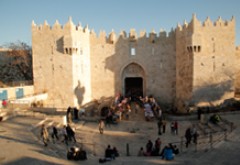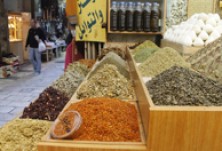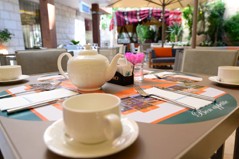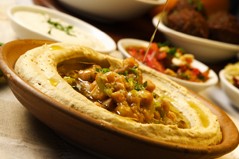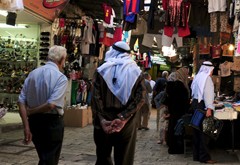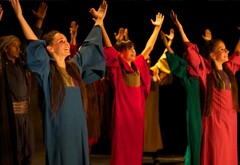Handicrafts in Jerusalem varied, responding to the needs of the City and its visitors. Many handicrafts related to souvenirs prospered for some time, but as a result of mechanization and mass production, some of them disappeared, although others managed to survive.
Candle Industry
Jerusalem was known for candle-making for many centuries, to meet religious needs, particularly in churches, convents, religious monuments, and religious and social events. The traditional candle industry developed overtime, with candles of different shapes and sizes, ornamented with different human and plant motifs, religious figures, and designs being produced. Some products were also gilded. The produced candles were used locally, and pilgrims took them as souvenirs to their countries.
Egg-Painting
This is a unique and an unusual handicraft that was linked to religious tourism and Easter celebrations. Many of the products were actual works of art. Eggs were placed in baskets made from palm tree leaves. Although some Jerusalem families were specialized in this handicraft, nuns were also involved in the production of painted eggs.
Glazed Ceramics and Pottery
This handicraft was absent for a long time from Jerusalem, after disappearing for centuries. It returned during the second part of the twentieth century to become the most significant handicraft for which Jerusalem is known. The development of this handicraft was connected to renovating ceramic tiles in the Dome of the Rock, and since then, it has advanced gradually, becoming a distinctive product of the City. The local knowhow in producing glazed ceramics improved after the Supreme Islamic Council renovated the ceramic tiling of the Dome of the Rock in 1920-1922. Today, Jerusalem produces large quantities of ceramic products, including household products and tiles sold in the local markets and exported internationally. Jerusalem has also preserved the Armenian / Turkish methods of producing ceramics, although Hebron started to compete in this field, exporting large quantities of their products to the Jerusalem markets. Ceramic products can be seen in most souvenir shops and other visitor-oriented outlets, and range from household cups, plates, dishes, and pots, and also include tiles and wall-hangings. The craft was expanded to include the making of murals, floor designs, and tables of different shapes and sizes, all covered with colorful tiles and designs. There is a wide variety available for the visitor, who can join tours to some workshops and observe the production process, both inside the Old City and outside its walls, to observe the production processes.
The traditional pottery production was born with the City itself, and continued over the ages until the middle of the 20th century. Jerusalem was famous in producing pottery pipes used in water and sewage drainage systems, and roof tiles. Unfortunately, the last pottery factory disappeared in the middle of the 20th century, and what is currently seen in the City markets is produced in some pottery factories in the West Bank.
Icons
Painting icons is an old handicraft that goes back to the Byzantine period, and is normally practiced in different east church monasteries. Jerusalem produces large numbers of icons in different styles, including Russian, Greek, Coptic, Syriac, and others.
Olive Wood
With olive wood plentiful in large quantities in Palestine, a large industry based on shaping it into different figures, statuettes, and shapes, like nativity sets and religious figurines.
This handicraft was famous in Jerusalem in the past, but disappeared gradually, with the last workshop closing down in the 1980s. The industry is now concentrated in the area of Bethlehem which produces large quantities and a wide range of olive-wood products, supplying the Jerusalem market with items that continue to be popular among tourists and pilgrims, and which are unique and typical of the Holy Land.
Gold and Silver Handicrafts
It seems that gold and silver handicrafts, which continue to assume a prominent position among handicrafts and in trade in Jerusalem, were prominent among other handicrafts. The Turkish traveler, Elia Shalabi wrote in 1769: "In Jerusalem, there is a substantial number of goldsmiths and silversmiths, and traders of jewelry. Jerusalem has every sort and type of metal formation handicraft in the world." Gold and silver smiths had their own independent market, and their craft was reinforced with the arrival of Armenian immigrants, who excelled in this craft since the turn of the 20th century. The City is known to have housed more than 50 gold and silver workshops at the turn of the 19th century. In time, these crafts expanded and artisans working in gold and silver increased in numbers and their products became more diverse, especially after they moved their center from Souk Al-Khawajat, adjacent to Souk Al-Attarin (Spice Traders) to Aftimos Market (Tanning Market).
Textile Industry
There is evidence that this industry occupied a significant position in the economy of Jerusalem. Women in Jerusalem, at the turn of the 19th century, owned many looms and wove for commercial purposes in addition to their family needs. There were also many industrial looms around the Bimaristan area, estimated at 10 looms in the 19th century in Jerusalem alone. Their production of textiles was sufficient to cover the needs of the peasantry and Bedouins who frequented the Jerusalem markets. There were attempts to revive this industry in 1919 when the American Red Cross Society placed looms in Al-Qattanin market (Cotton-Traders Market) after renovating it in cooperation with the Islamic Awqaf, in order to provide employment for a large number of Armenia refugees who arrived in Jerusalem in 1917. The project was later adopted by the Pro-Jerusalem Society). The number of people working in this craft was 70 skilled workers, producing different types of textiles. They were supported by the most prominent Palestinian weavers from the coastal city of Majdal, known for its textile weaving industry. The weaving industry thus prospered in the City, but not for long, unfortunately, as it gradually moved outside the Old City and the arrival of industrially produced textiles using modern mechanization. Gradually, this craft disappeared with the last loom moved out of the Old City.
Tanning
It is clear that the tanning craft prospered in Jerusalem, occupying a central location in the Old City (Tanning Neighborhood), and producing large quantities of leather used in making shoes and bags, as well as water containers used for transporting water, drinking, and dairy production. Leather was also used to provide drinking water to pilgrims, and some of these containers were made from a whole goat's hide and carried by water suppliers to transport water to homes. This industry was moved out of the Holy City in the 1870s, and gradually receded afterwards. Although the trade of leather products prospered around the City's markets, trading in bags, apparel, and shoes, there were no tanneries any more in the City, and tanned leather was imported from the West Bank or from outside Palestine to cover the needs of the Jerusalem market, particularly of bags, shoes, and leather apparel.
Rosaries and Beads
Jerusalem, as a city of pilgrims and religious people, had a large number of workshops making rosaries and crosses from mother of pearl and bone, as well as olive wood and precious stones. This craft became quite famous, with rosaries representing preferred souvenirs and gifts carried home by pilgrims. This craft also gradually retreated in favor of Bethlehem, where mother-of-pearl crafts developed to a large extent.
Blacksmithing
Blacksmiths were concentrated in the northern part of the Butchers' market, next to the copper smiths. Local blacksmiths produced items like hammers and chisels, and masonry, blacksmithing, carpentry, and other professions' tools. Blacksmiths also made doors, windows, locks, grills, water pipes, etc. The number of blacksmithing workshops at the turn of the 19th century reached about 20, some of which were located inside different neighborhoods. This local craft continued to exist in the Butchers' market until the 1980s, but decreased gradually until only one is left there at this point. It is noteworthy that some monasteries had blacksmithing (and carpentry) workshops, such as the Franciscan Monastery (St. Salvador), the Armenian Monastery, and the Greek Orthodox Monastery. They provided their services to members of their communities as well as fulfilling the needs of the monastery itself, and sometimes to other communities, including Muslims. The Noble Sanctuary also had a blacksmith workshop.
Sesame Presses
Remnants of sesame presses are still clear in the City. Two of them continue to operate using traditional techniques. The most famous and attractive, preserving the traditional equipment and methods of sesame presses being the Abu Kamel Al-Salihi press on the road to Bab Al-Silsilah. In 1840, Jerusalem had 15 sesame presses, indicating that their production of sesame oil and Tahini (sesame paste) by far exceeded the needs of the City.
Building and Renovation Crafts
The Nimr family (Nammari) were the most prominent family of civil engineers and builders in the City throughout the Ottoman period. One of their children was known as Mi'mar Pasha. In a relatively alive and active city like Jerusalem, the building profession occupies an important position. Crafts included skills in masonry and stone and marble formation, gypsum preparation, building arches, vaults, and ribs with stones, plastering, tiling, etc. The presence of prominent buildings like Al-Aqsa Mosque, the Dome of the Rock, and the Church of the Holy Sepulcher required special building skills, including renovation, especially that buildings in Jerusalem survive for centuries, during which they require renovation and care.
Gypsum Frames and Windows
Jerusalem is considered one of very few cities that have a workshop for making gypsum window frames, located in the Holy Sanctuary, and making windows for the Islamic holy sites using the same historic methods and specifications and with a high level of quality and precision. After the criminal action of burning Al-Aqsa Mosque in 1969, this industry developed and prospered, partly for replacing all the Mosque's windows. Later on, all windows in the Noble Sanctuary area were replaced. The windows and frames produced by Al-Aqsa Mosque workshop is considered among the most beautiful and detailed in the world, including Egypt, Turkey, and North Africa.
Mosaics
As part of Al-Aqsa Mosque renovation effort after the 1969 arson as well, it became necessary to establish a wall-mosaics murals) workshop to replace what was lost inside the mosque. Towards the end of the twentieth century, a mosaics (murals and floors) school was established in Jericho, producing a prominent group of artists in forming and repairing mosaics. This group also performs renovation work I the Noble Sanctuary and churches in Jerusalem and the rest of the Palestinian cities. The latest mosaic renovation and formation project carried out was the Dome of the Rock, Al-Aqsa Mosque, and the Gethsemane Church (Church of Nations).
Bamboo and Wicker

